This guide details how to tie a popping cork for speckled trout and redfish, especially if you're fishing for them in Louisiana.
While I use a lot of casting tackle to throw lures for these fish, I almost always have a popping cork rigged on spinning tackle ready to rock 'n' roll! That's because popping corks are a mainstay and proven way to catch fish. Sometimes speckled trout and redfish just bite a cork better than they bite anything else! In fact, if you've kept up with my fishing trip videos on YouTube, then you know that the popping cork just did the job better than anything else. From Dularge to Pointe à la Hache it was the venerable popping cork that caught speckled trout the best!
But how do you tie a popping cork? What's the best way to fish it?
Many anglers have their own way of doing this, but in this guide I'll cut through the confusion to show you the method that has worked best for me. This is based upon years of experience fishing various tackle, guiding clients in the marsh and making my full-time living running Louisiana Fishing Blog and LAFB Elite. I've caught a lot of fish with my rig, to include limits of speckled trout and redfish, but also other species such as black drum, triple tail, and more.
The Best Overall Popping Cork Rig That I Use
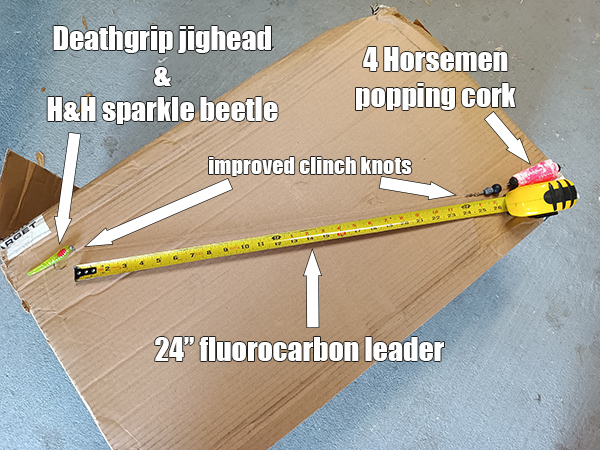
What you see above is comprised of:
How To Tie A Popping Cork For Speckled Trout & Redfish
You begin by measuring out 24 inches of 20lb test fluorocarbon leader and cutting it free of the spool. Then tie one end to the bottom of the Four Horsemen popping cork with an improved clinch knot and the other end to the 1/16th oz Deathgrip jighead, also with an improved clinch knot. Remember to wet the knots before tightening them. Saliva works just fine.
Then you want to thread a sparkle beetle onto the jighead. The Deathgrip's design is in the name: lures won't come off this specialized jighead! But it goes both ways: they can also be difficult to thread lures on. So I suggest wetting the ribs with a little saliva to allow the sparkle beetle to slide on. Exercise caution!
Lastly, tie your spinning combo's main line to the top of the Four Horsemen popping cork. That's it! Now you're ready to fish a popping cork for speckled trout and redfish.
However, there are additional details below if you are interested to learn why I rig a popping cork in this manner.
Why I Use The Above Tackle & Method
There's a thousand ways to skin the proverbial cat, and everyone and their mom has their own way of tying a popping cork for speckled trout and redfish. But why do I do it the way you see above? Well, let me explain myself here:
Why the Four Horsemen popping cork?
Because it's the best. Yes, they're a little pricier, but they will last longer. That and their "pop" sound is unique and like no other. It should come as no surprise that this cork is designed and sold by speckled trout expert Captain Aaron Pierce, an established and experienced inshore fishing guide based out of Golden Meadow.
And I'll leave it at that. If you want to learn more then please consider this guide to the best popping cork for specks and reds.
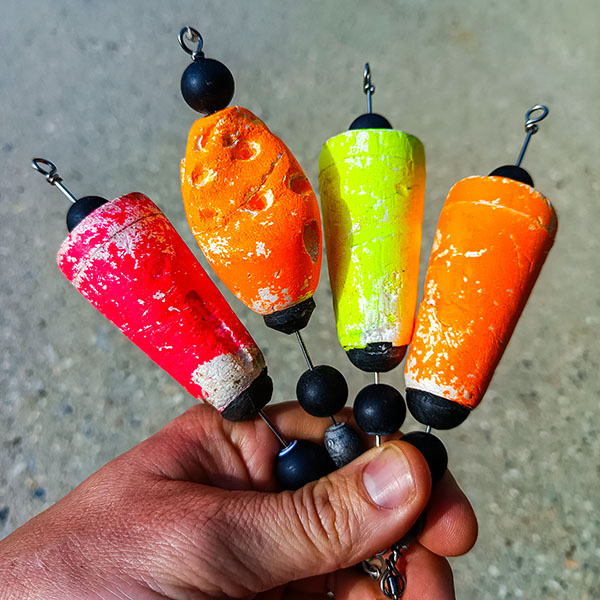
The popping cork second from left was bit by an alligator and is still catching fish today!
Why fluorocarbon?
Because it makes me feel warm and fuzzy, especially when fishing in clearer water. In this video from Marsh Man Masson at 10:22 you can see how obvious his 30lb monofilament leader is underwater (that he mentions at 9:13). I don't think this is a deal-breaker or will absolutely keep anyone from catching fish, but the fluorocarbon does remove any doubt in my mind.
With that said, I do recommend 20lb monofilament as a leader line because it's cheap and easy to use. I just go the extra mile with fluoro, and it's okay if you do, too. Since we're here, I use Seaguar InvizX, but I think any name brand will do.
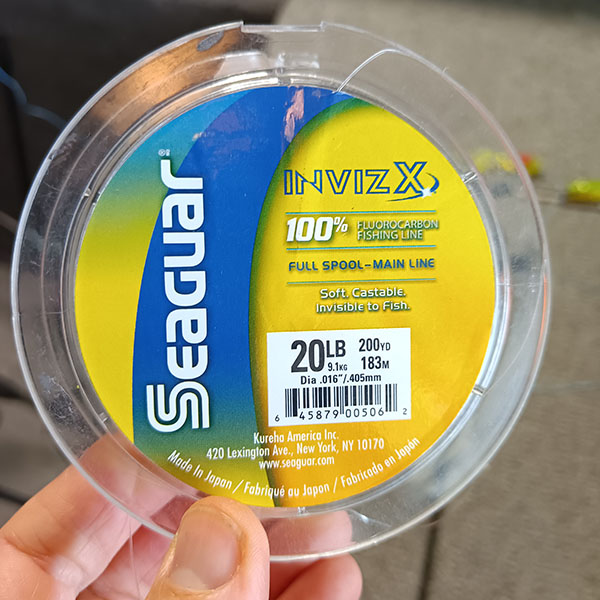
Why the improved clinch knot?
Because it's simple and it works. Bang. That's it. Don't be a knot nerd and make this harder than it needs to be. If there's a strong knot you're confident tying, then you can use that instead. It doesn't really matter. There are far more important things to belly-ache over, like finding biting fish in the first place.
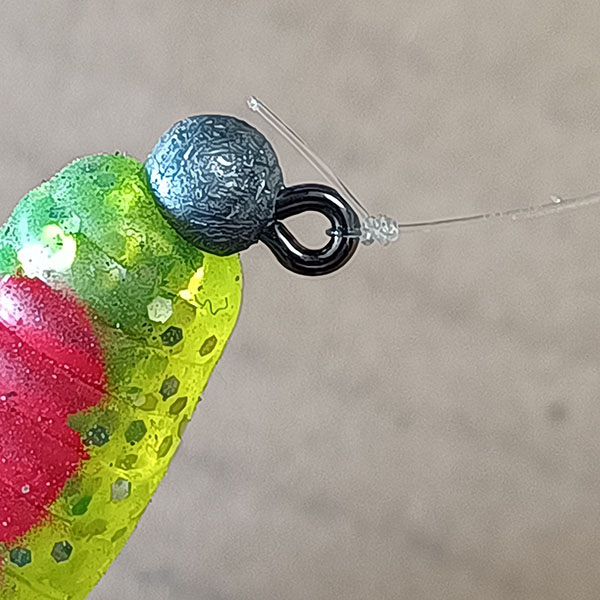
The Improved Clinch Knot holds up great against limits of trout and the biggest bull redfish.
Why the sparkle beetle? Why chartreuse?
Same as above: because it's simple and it works.
The fish you're trying to catch are not tournament-winning largemouth bass in Lake Conroe on Day Three of the Bassmaster Classic. They are slot speckled trout and redfish, nearly the dumbest fish in the world and — by extension — reasonably easy to catch.
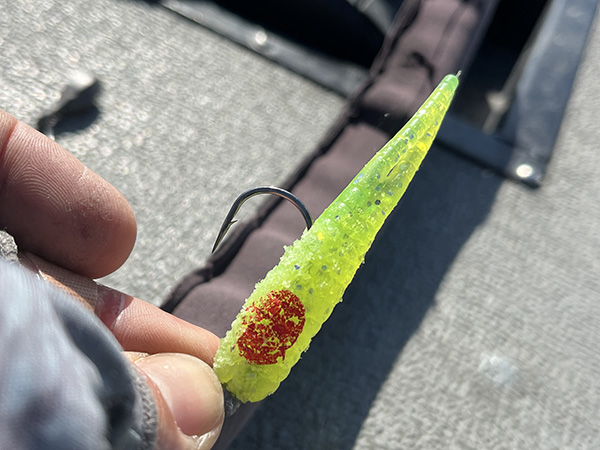
The sparkle beetle just works. Note how chewed up it is from catching speckled trout and redfish all day!
The chartreuse sparkle beetle is a mainstay and proven winner. I've caught untold amounts of fish on this soft plastic and that's because I'm an expert at:
- finding them in the first place
- putting a lure where they can bite it
It really is that simple. If you find yourself experimenting with lure color under a cork then I've got news for you: you're doing it wrong, you're probably casting at empty water and — last, but not least — you need to revisit #1 and #2 above. Fortunately for you, that's what I specialize in here on this website and you will find all-in-one-spot inside my flagship course, Inshore Fishing 101.
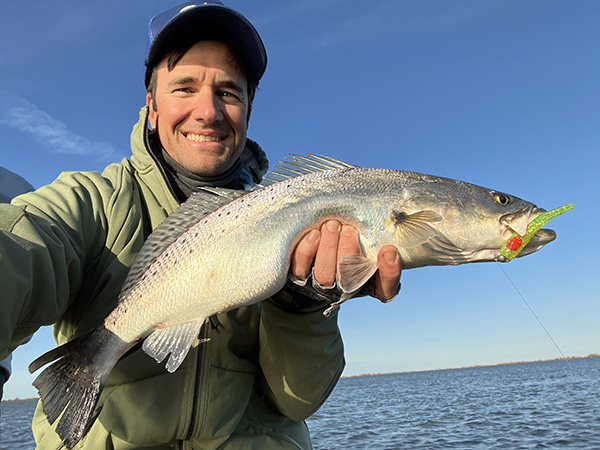
Even the "nicer" speckled trout you would catch for Release Over 20 readily take a sparkle beetle. The key is finding them in the first place.
Why the Deathgrip Jighead?
I use the Deathgrip jighead because it has extra ribs on the body that hold the sparkle beetle on. Conventional jigheads that cost less lack this feature and, as a result, allow the soft plastic to slip off as it gets worn.
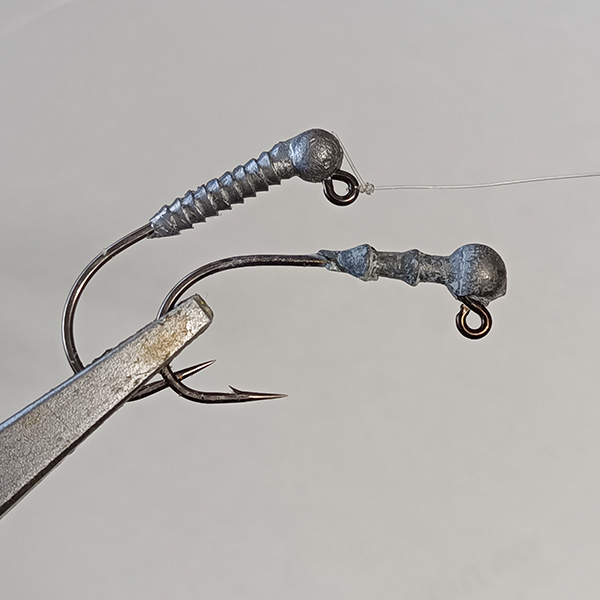
The Deathgrip jighead (pictured on top) is a great choice for how to tie a popping cork.
You can use a different jighead if you like, but I recommend sticking with 1/16th ounce because it provides better action. It doesn't sink too fast and really allows the bait to move with each "pop" of the cork.
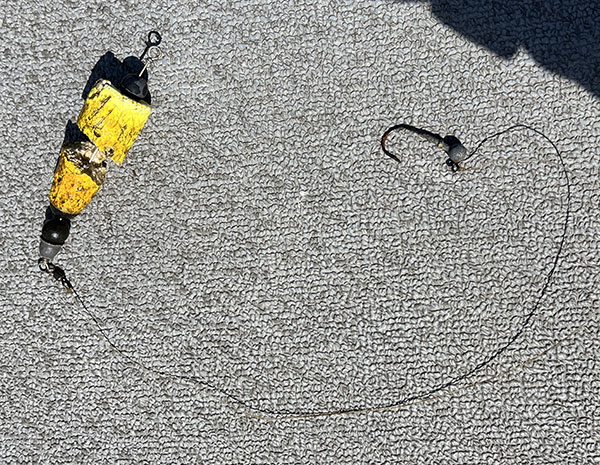
I found this old popping cork rig broken off on cane stubble in Venice. Apparently I'm not the only one who thinks this is a great setup for speckled trout and redfish!
What's The Best Way To Fish Popping Corks For Speckled Trout?
My preferred method is to cast out to where I think the fish could be, and pop the cork every two seconds, taking up slack. I don't let it sit. I keep it moving to cover water and make noise, drawing attention to it. When I catch a fish, I'll cast back to where I caught him as fast as possible to see if there is a school there.
Sometimes the fish are schooled up, sometimes they are spread out. If they are schooled up, I'll anchor the boat and keep casting back to that spot to catch my limit. If they're spread out, then I'll keep drifting with the wind and keep casting. Optimum drift speed tends to be ~0.5mph and less than 1mph. So if I'm drifting "too fast" then I'll use a drift sock to slow down.
If there's no wind to drift the boat then I'll sparingly use the trolling motor to keep covering water. After that, I'm certain to fan cast around the boat if fish appear to be spread out.
You can see this in action in this fishing trip to Dularge (drifting) and this fishing trip to Delacroix (trolling motor).
How To Fish Popping Corks For Redfish
When targeting redfish, I really prefer to sight fish for them. But sometimes blind-casting to them with a popping cork is the way to go! So when throwing a cork for redfish I tend to cast against a shoreline and pop it at a slower frequency than I do trout. Once I catch one, I do the same for reds as I do specks: cast back out to see if more are there and, if not, then keep the boat moving.
Sometimes they're bunched up, sometimes they're patrolling a shoreline in singles and doubles.
Because redfish tend to feed shallower than speckled trout, I will delay setting the hook when I see the cork move. This is because the leader may be deeper than the water is in. Setting the hook prematurely could result in a missed fish!
Extra Considerations For Tying A Popping Cork For Speckled Trout & Redfish
While writing this guide I thought of some additional tips and tricks for fishing a popping cork that I couldn't fit above, so I decided to put them here:
First, consider tying a monofilament leader above the popping cork then securing it to the mainline with a uni-to-uni knot. Mono is more rigid than braid and tends to tangle less. I've experimented with this and it certainly works, but I have not found it to be a deal-breaker. Tying straight to your braided main line works fine and is what I usually do.
Second, the recommendation for using 24 inches as a leader length is only a guideline. You can go shorter or longer. For example, earlier this year I was fishing Delacroix during really low water levels and found myself using leaders as short as twelve inches to accommodate the speckled trout. Other times in deeper water I've been successful with leaders as long as 40 inches.
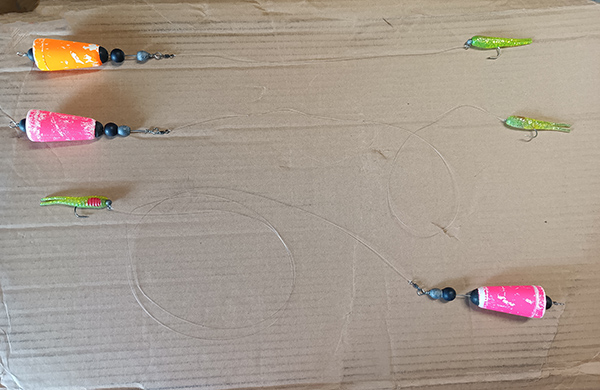
As you can see, I use various leader lengths to match the scenario. The top is 18", middle 24" and bottom 40".
Third, you should have popping cork rigs tied and ready to go in plastic bags. This makes for tangle-free organization and they are readily available in the event you need them on the water. Time spent tying tackle = time spent not reeling in fish.
Fourth, using dead shrimp or even Gulp in lieu of the sparkle beetle is a great way to catch redfish. It does help. However, this does not change my stance on fishing with live bait overall: just don't.
Next, if you are fishing with a long leader, then consider securing the hook by going under the reel stem and up to the hook keeper or secure it to the frame of the bottom-most line guide. Just don't put the hook on the line guide, as it can scratch it and cause your line to fray over time.
What if you want to fish deep?
The popping cork isn't always the best rig for catching speckled trout and redfish. It really only succeeds in shallower water, or whenever fish are feeding at the surface (with diving birds being an example).
So what if fish are feeding in deeper water? In that scenario you want to be able to reach the bottom of the water column, and the most simple-stupid rig to do that is the Heavy Drop Shot.
But there's more! Fishing shallow with a popping cork is easy. Anybody with a pulse can do it and that explains why it's such a popular choice in tackle. But catching fish deep requires more knowledge and skill, and that's where many inshore anglers drop the ball.
Have no fear, because I made this free video course detailing how to overcome the challenges of fishing deep.
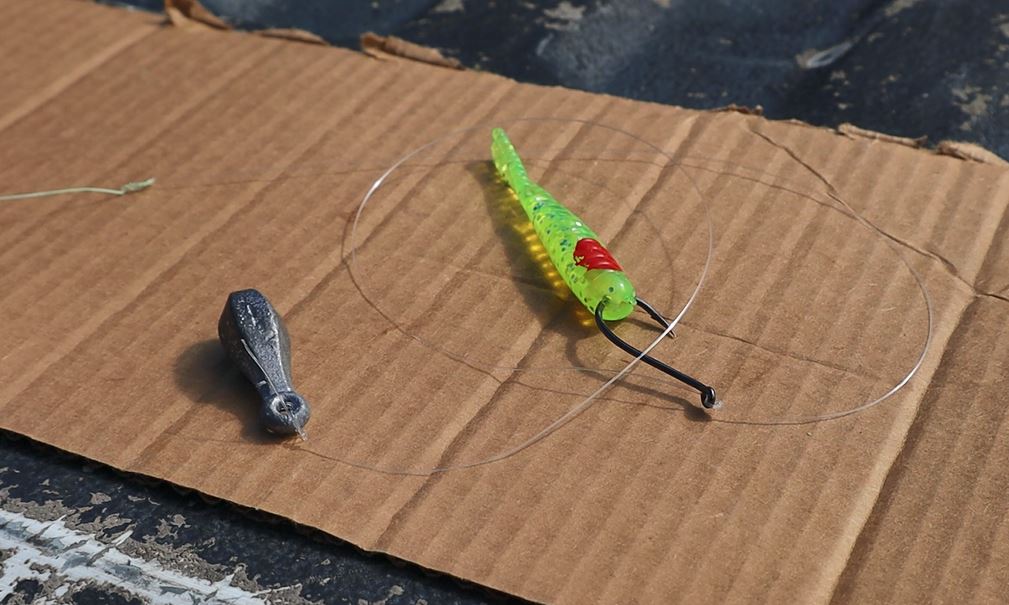
The Heavy Drop Shot is a better fit for catching speckled trout and redfish in water too deep for a popping cork.
The #1 thing you need to do...
Remember earlier the #1 thing I said that is most important? That's right: finding fish to begin with.
If you can do that then you will be a formidable inshore angler who consistently catches fish, even limits of fish. This skill is what I am best at. Find the fish in the first place and it really won't matter what you have tied on, so long as there's a hook on it and the fish can see it.
This #1 thing is what I teach first and foremost in my courses inside LAFB Elite, my exclusive membership for inshore anglers willing to learn how I do it and apply that knowledge on the water.
”
Captain Devin, I would like to thank for all your hard work. Inshore Fishing 101 is about as thorough as you could get.
I would like tell you my situation: I live in north Louisiana by Bossier City. I only get to go to fish the coast once or twice a year and have been putting off signing up for LAFB Elite because of that.
I finally broke down, joined your membership, took Inshore Fishing 101 and am very glad that I did. I will go over it quite often before my next fishing trip.
Once again, thank you for all your hard work!
George Smith / North Louisiana Native
”
I thoroughly enjoyed the Inshore Fishing 101 experience. The overall knowledge makes me feel more prepared to find fish on a consistent basis. I've been fishing in inshore Louisiana waters my entire life. While some of the knowledge was not new, the way it is presented with new material really seemed to tie everything together for me.
My biggest take away from 101 was the ability to pick (potentially) productive fishing spots. How to appropriately select weight and why was another huge help. I feel much more prepared for hitting the water!
John Fortner / Louisiana Native
”
I loved the easiness of going through Inshore Fishing 101, and that I could go back and redo a video lesson.
The content is outstanding! Devin is easy to listen to and follow along. His passion and knowledge of our fabulous fishery is something everyone that wants to better their game should consider.
I have done my best to transfer my knowledge of the marsh to my grandsons. They will watch Inshore Fishing 101, at a minimum.
Leo Damaris / Grandfather
”
LAFB Elite is great. I earned a lot and look forward to putting that knowledge to use!
Also, I love being able to go back into the courses and refresh what I’ve learned before and after trips in order to see what can make the next trip better.
I may only get to go a few times in a year so I need to make the most out of my trips!
Jamie Traweek / North Louisiana Transplant
Got something on your mind?
Do you have a question or comment? Perhaps you have a better way of tying a popping cork for speckled trout and redfish? If so, then please use the comments section below. I love it when people comment on my website!

Do you have any tips or tricks for tying a popping cork? If so, please post them here. Thank you so much!